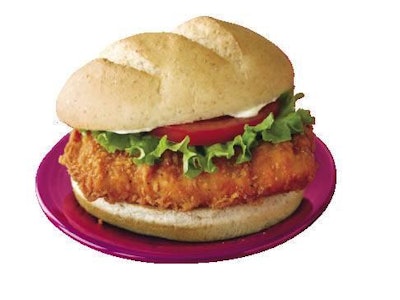
Chicken is hot at McDonald’s. With the chain already offering a dozen chicken items in its 13,700 U.S. restaurants, one of the newest menu additions is the Spicy Premium Chicken Sandwich. McDonald’s sells about $5 billion of chicken products annually, say analysts, who foresee perhaps another $1 billion in chicken sales over the next three years. Already, 5.5 million broilers per week are needed to meet customer demand for McDonald’s products.
Ralph Alvarez, president, McDonald’s North America, said, “Customers continue to tell us that they want great-tasting menu choices with new flavor and more variety. As a result, quality chicken products represent an important part of our menu.”
McDonald’s vice president of menu management in the USA, Wade Thoma, told WATT PoultryUSA, “Chicken sales have driven about 40 percent of McDonald’s total growth over the last three years and continue to play a big role in our growth.” Importantly for McDonald’s, this growth has resulted from bringing new customers into restaurants and has not been at the expense of existing beef sales.
McDonald’s leads the U.S. foodservice industry in sales of chicken strips and chicken sandwiches. The company sells more than 600 million pounds of chicken each year. In 2005, McDonald’s recorded a 27 percent share of chicken sandwiches, more than its top three competitors combined.
Dominating the chicken sandwich category is important to the fast-food marketer, not just in terms of the revenue generated, but for additional reasons significant to marketing and profitability. Analysts report that the trend toward more chicken helps fast-food chains, like McDonald’s, stabilize food costs and minimize the “veto factor” if a family member does not want a hamburger.
The Spicy Premium Chicken Sandwich, which was rolled out by the company in January, is now the leading seller among the chain’s six chicken sandwiches, according to Thoma. The addition of the Spicy Premium Chicken Sandwich does not just reflect the tastes of McDonald’s customers. According to a national survey, 85 percent of Americans say they like foods that are “bold, hot and spicy.” Served on a warm honey wheat roll with lettuce, tomato and mayonnaise, the sandwich combines smoked Jalapeno, Cayenne pepper and other spices.
“Consumers’ interest in spicy foods has been growing, particularly among ethnic sectors, and we worked for some time to find the level of spiciness that would appeal to the broadest group of customers,” Thoma explained. While finding the right level of spiciness was the biggest marketing hurdle in creating the sandwich, delivering that attribute consistently in a chicken patty added to the challenge.
“It’s easier to deliver the desired spice level in a sauce, rather than in the patty, itself,” he added. “Consumers have a decided preference for the patty to be spicy and not the sauce that comes on the sandwich to be spicy, and to some degree, delivering a spicy patty was more difficult.”
Thoma gives the company’s chicken industry suppliers high marks for their work in helping create new products like the Spicy Premium Chicken Sandwich. McDonald’s white meat chicken is produced in the USA by Tyson Foods and Keystone Foods.
“McDonald’s key chicken suppliers are some of our strongest partners among all of our suppliers. We’re working with them day-in and day-out not only on new chicken items but also on ways to improve the chicken products that McDonald’s already offers,” he said.
“Kudos to the folks who work in the chicken industry,” he continued, “because there’s been far more innovation with chicken than there has been with beef over the last ten years. And, I think the chicken industry has been much more responsive to what consumers want.”
That industry responsiveness, combined with product characteristics that are in sync with consumer demand, have helped to put more and more chicken items on the McDonald’s menu board. “If you added them all up, there are about thirteen different ways to get chicken at McDonald’s, and I would expect us to continue to offer more ways,” he said.
“Chicken consumption surpassed beef on a per capita basis several years ago in the USA,” Thoma noted, “and the trends that drove that are still in place. Chicken fits very much into the American lifestyle. It’s a food that people feel good about eating and is convenient and affordable. And it’s very versatile, lending itself to delivering a range of flavors in a variety of forms.”
Chicken, for example, has been an integral factor in driving the demand for salads at McDonald’s and other fast-food restaurants. Up until a few years ago, few consumers were eating salads as an entrée. Now, with the addition of chicken as a topping, salads represent an important fast-food entrée category, and it’s a category owned by chicken.
“At McDonald’s, we don’t even merchandise a salad without chicken on it,” Thoma noted. “It has become a driver of why people want to eat our salads.”
The continuing rise in the popularity of ethnic foods in the USA is another factor expected to keep chicken in a “sweet spot” of consumer demand. “As America becomes more and more ethnic based, people can be expected to eat more and more chicken at home as well as when they eat out. An important reason is that chicken is a great carrier of so many different kinds of flavors,” Thoma said.
With the introduction of the Spicy Premium Chicken Sandwich, it can be said, figuratively and literally, that chicken is hot at McDonald’s.


















